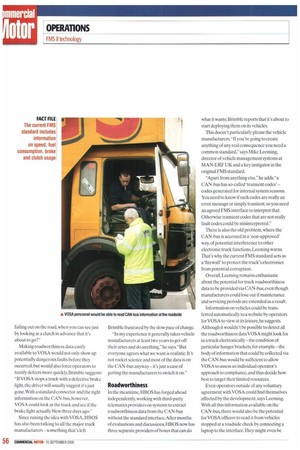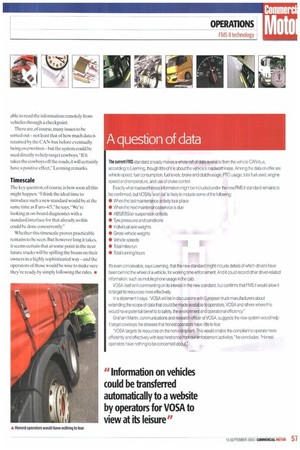TRIAL BY TECHNOLOGY
Page 57

Page 58

Page 59

If you've noticed an error in this article please click here to report it so we can fix it.
In a few years' time VOSA may be able to find out everything it wants to about your trucks, simply by taking the information from your vehicles' CAN-bus systems. Robin Meczes reports on this brave new world...
Technology marches inexorably on. And just as law enforcement agencies seized upon CCTV a few years ago to help them maintain order in city centres on a Saturday night, so those responsible for policing vehicle compliance are now turning their attention towards telematics technology in their fight to maintain order on the roads.
The potential for sophisticated IT systems to report on a truck's condition is obvious. Ever since the development of CAN-bus essentially a 'ring main' on the truck into which various truck sub-systems can be networked to share dataand the subsequent development of the FMS interface a standard interface that lets telematics systems interrogate the CAN-bus in an approved way the writing has been on the wall.
Little wonder, perhaps, that VOSA is about to meet with ACEA, the European Automobile Manufacturers Association, to begin discussing the kind of information it would like to get from such systems and how vehicle manufacturers can make that information available via a new CAN-bus interface standard, currently dubbed FMS II.
The drive to access roadworthiness information via the CAN-bus has been fuelled by Halifax Bank of Scotland (HBOS). With two vehicle-rental and contract-hire firms in its portfolio (Hill Hire, which it owns outright; and Lex Vehicle Leasing, a joint venture with the RAC),HBOS naturally has an interest in vehicle management.
Dispensation It was HBOS that originally sparkedVOSA's interest in the subject by approaching it about 18 months ago to discuss the possibility of being granted a dispensation on maintenance and inspection periods in return for making vehicle roadworthiness data available to VOSA on a voluntary basis -data effectively generated by the vehicle itself.
"We approached VOSA and said we'd like to look at stretching inspection cycles," says Chris Brimble, director of services at HBOS. "If we can do that, we'd obviously be getting our costs down."
There would also be a health and safety benefit,Brimble believes. "Like any vehicle manager, we feel fairly safe for the first couple of years of a vehicle's life, but after that you're more likely to get problems with things like brakes and clutches, and these are problems you can predict.
-If you can see something starting to go wrong before it does, it's obviously an opportunity. Why do we still get clutches failing out on the road, when you can see just by looking at a clutch in advance that it's about to go?
Making roadworthiness data easily available to VOSA would not only show up potentially dangerous faults before they occurred, but would also force operators to rectify defects more quickly, Brimble suggests: "If VOSA stops a truck with a defective brake light, the driver will usually suggest it's just gone. With a standard connector and the right information on the CAN-bus, however, VOSA could look at the truck and see if the brake light actually blew three days ago."
Since raising the idea with VOSA, HBOS has also been talking to all the major truck manufacturerssomething that's left Brimble frustrated by the slow pace of change.
"In my experience it generally takes vehicle manufacturers at least two years to get off their arses and do anything," he says. "But everyone agrees what we want is realistic. It's not rocket science and most of the data is on the CAN-bus anyway it's just a case of getting the manufacturers to switch it on."
Roadworthiness In the meantime, HB OS has forged ahead independently, working with third-party telematics providers on systems to extract roadworthiness data from the CAN-bus without the standard interface. After months of evaluations and discussions, HBOS now has three separate providers of boxes that can do what it wants; Brimble reports that it's about to start deploying them on its vehicles.
This doesn't particularly please the vehicle manufacturers."If you're going to create anything of any real consequence you need a common standard," says Mike Leeming, director of vehicle management systems at MAN-ERF UK and a key instigator in the original FMS standard.
"Apart from anything else," he adds,"a CAN-bus has so-called 'transient codes' codes generated for internal system reasons. You need to know if such codes are really an error message or simply transient, so you need an agreed FMS interface to interpret that. Otherwise transient codes that are not really fault codes could be misinterpreted."
There is also the old problem, where the CAN-bus is accessed in anon-approved' way, of potential interference to other electronic truck functions, Leeming warns. That's why the current FMS standard acts as a 'firewall' to protect the truck's electronics from potential corruption.
Overall, Leeming remains enthusiastic about the potential for truck roadworthiness data to be provided via CAN-bus, even though manufacturers could lose out if maintenance and servicing periods are extended as a result.
Information on vehicles could be transferred automatically to a website by operators for VOSA to view at its leisure, he suggests. Although it wouldn't be possible to detect all the roadworthiness data VOSA might look for in a truck electronically the condition of particular hanger brackets, for examplethe body of information that could be collected via the CAN-bus would be sufficient to allow VOSA to assess an individual operator's approach to compliance, and thus decide bow best to target their limited resources Even operators outside of any voluntary agreement with VOSA could find themselves affected by the development, says Leeming. With all this information available on the CAN-bus, there would also be the potential for VOSA officers to read it from vehicles stopped at a roadside check by connecting a laptop to the interface. They might even be able to read the information remotely from vehicles through a checkpoint.
There are, of course, many issues to be sorted out — not least that of how much data is retained by the CAN-bus before eventually being overwritten—but the system could be used directly to help target cowboys. "if it takes the cowboys off the roads, it will certainly have a positive effect," Leeming remarks.
Timescale
The key question, of course, is how soon all this might happen. "I think the ideal time to introduce such a new standard would be at the same time as Euro-4/5," he says. "We're looking at on-hoard diagnostics with a standard interface for that already, so this could be done concurrently."
Whether this timescale proves practicable remains to be seen. But however long it takes, it seems certain that at some point in the near future trucks will be spilling the beans on their owners in a highly sophisticated way— and the operators of those would be wise to make sure they're ready, by simply following the rules. •






































































































































































































